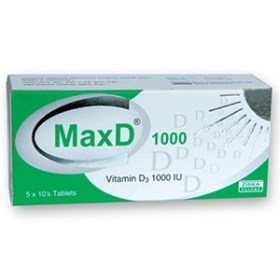Vitamin D3 deficiency can occur in people whose exposure to sunlight is limited and in those whose diet is deficient in vitamin D3 . Vitamin D3 is essential for the effective calcium and phosphate absorption required for healthy bones and teeth, preventing rickets, osteomalacia and osteoporosis. Vitamin D3 is important during pregnancy and breast-feeding, an essential nutrient for a growing infant. It is also essential to prevent pre-eclampsia during pregnanc
Dosage & Administration
1000 IU (1 tablet) daily, or as directed by physician. Swallow the tablets
with a full glass of water. Take the medicine with food or within 1 hour after a meal.Patients receiving doses of Vitamin D 3 should have their plasma-calcium concentration checked at \intervals (initially once or twice weekly) and whenever nausea or vomiting occu
Contraindications
Vitamin D3 is contraindicated in all diseases associated with hypercalcaemia. It is also contraindicated in patients with known hypersensitivity to Vitamin D 3 (or medicines of the same class) and any of the excipients. It is contraindicated if there is evidence of Vitamin D3 toxicity
Symptoms rarely include anorexia, lassitude, nausea & vomiting, diarrhea, constipation, weight loss, polyuria, sweating, headache, thirst, vertigo, and raised concentrations of calcium andphosphate in plasma and urine.
Plasma-calcium concentration should be monitored at intervals in patients receiving high doses of Vitamin D3, in renal impairment, and during pregnancy & lactation. People using Digoxin and Thiazide Diuretics should consult a health care practitioner before supplementing with Vitamin D3. People with liver or kidney disease, primary hyperthyroidism, lymphoma, tuberculosis and granulomatous disease should consult a health care practitioner before supplementing with Vitamin D3
During pregnancy Vitamin D3needs are increased. Vitamin D3deficiency duringpregnancy can affect bone development and immune function from birth through adulthood. Low Vitamin D3 levels are common among those taking a standard prenatal multivitamin, which usuallycontains 400 IU, but is inadequate for pregnant women. Even 800 IU of Vitamin D3 per day didn’t permitmost pregnant women to reach a normal Vitamin D3level. A recently completed study funded by theNational Institutes of Health tested the safety and effectiveness of 4000 IU Vitamin D3per day inpregnant women. The researchers reported that this dose was safe and effective in achieving normal Vitamin D3 levels and resulted in fewer pregnancy complications (infections, preterm labor, and birth)when compared with 400 IU Vitamin D3per day. A deficiency of Vitamin D 3 has also been linked to a greater risk of pregnancy complications, including pre-eclampsia
Use in Lactation:
It should be assumed that exogenous Vitamin D3 passes into the breast milk. In view of the potential for hypercalcaemia in the mother and for adverse reactions from Vitamin D3 in nursing infants, mothers may breastfeed while taking Vitamin D3, provided that the serum Calcium levels of the mother and infant are monitored. The American Academy of Pediatrics (AAP) currently recommends that breastfed infants receiving a supplement of Vitamin D3 every day prevent Vitamin D3 deficiency and rickets. This is because the Vitamin D3 content of breast milk is related to the mothers Vitamin D3level, and most lactating mothers’ Vitamin D3 stores are not adequate to provide their baby with enough Vitamin D3 through breast milk alone












Reviews
There are no reviews yet.